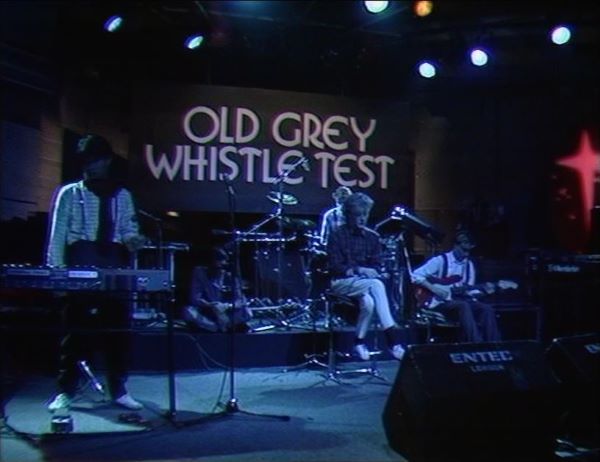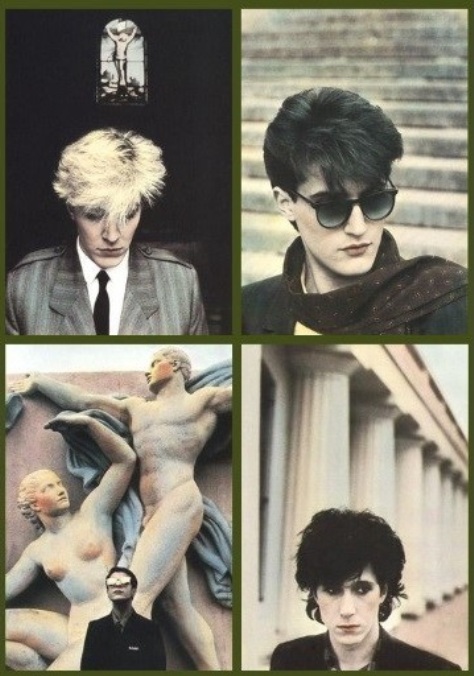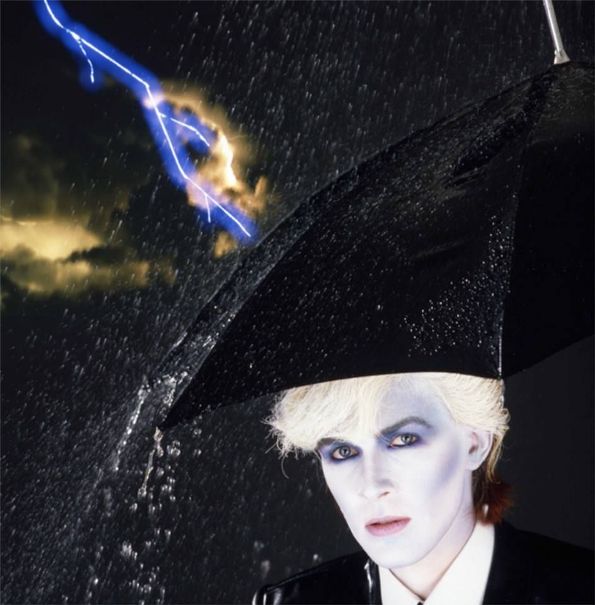Sometimes it’s difficult to remember why you made a particular decision. Especially one that you wish you could change afterwards… It was late 1982 and I was in the final year at school. Important exams were looming the following year which would determine whether I would achieve my ambition of going to university, and if so, which one I might attend. My fascination with Japan had developed in the preceding months as the singles ‘Ghosts’ and ‘Cantonese Boy’ had been lifted from Tin Drum, catching my attention and drawing me to the album. The plethora of Hansa singles had got me exploring the back catalogue, and I was guided through by an enthusiastic friend.
Sometime in the weeks before Japan’s series of six concerts at the Hammersmith Odeon in London, my friend had some important news for me. He had a contact who had bought tickets for a number of the London shows, but had now decided not to attend them all. There was a spare ticket and I could buy it!
Why didn’t I go?? I can remember him saying, ‘This is most likely the last chance to see them play live!’ Maybe it was mid-week and given the travel time from mid-Kent and the need to attend school the next day, logistics would have been tricky and approval from parents unlikely. ‘Mock’ exams may well have been taking place at the time. Maybe the ticket wasn’t for the night that my friend attended, so I’d have had to go alone. Maybe I didn’t have the cash. I honestly don’t know… but I do know this: it would have been fantastic to have seen the band live, even just that once. I regretted it almost instantly. There was talk of an additional show at the Royal Opera House, with Japan being the first band to play there. I scoured the music press for the announcement. It never came.
‘There was going to be a gig at the Opera House,’ Sylvian explained later. ‘That was a charity show, but we cancelled it because we knew this [the live album Oil on Canvas] wouldn’t be finished and we just thought it best to end in Japan. End in Hammersmith, as we did. It’s not worth doing six shows and then coming back for one more.’
The following year, David Sylvian and Steve Jansen spoke on BBC Radio One about the release of Oil on Canvas. ‘Listening to the live album, it’s just documentation,’ said David. ‘You’re just giving it as, “this is what Japan did. This is how they finished the last tour,” and so on…it’s no more than that.’ His words were a little dismissive, but for those of us who hadn’t been present at the shows the release of the video and double album was truly welcome. It was an insight into their stage show that I would otherwise only have known through poorly-recorded cassettes procured later from Camden Town market during my London student years. The sky-blue Sons of Pioneers tour programme obtained for me by my school pal was a nice memento, but no amount of imagination could take me into the Hammersmith stalls for that performance.
The VHS video of Oil on Canvas was released in the UK many weeks before the double-vinyl live set. This was a time when video-cassettes came in over-sized cases and were exorbitantly expensive. Magazine clippings from the time show it retailed at between £20 and £25. That’s an eye-watering £68-£85 in today’s money. I had to have it, even though it would cost me a month’s money from my weekend job. The tape was ordered from a local shop and once it arrived arrangements were made for my Japan-crazy schoolmate and I to view the premiere in our front room – a daytime viewing with curtains closed in arrangements only usually put in place for the annual FA Cup final.
I drank it in. The stage set and lighting. The stylish costumes. The Chinese pictures interwoven with images of the band during the opening track, and then the archive and specially-commissioned footage skilfully integrated with later pieces. Mick’s stage shuffle and confident gait. David clutching the air as he delivers the lines. Richard ice-cool and understated. Masami’s gushing guitar gestures. It was seeing the music performed that was the greatest joy, and nothing was more captivating than witnessing Steve deliver the intricate drum patterns that I’d become so familiar with through multiple listens of the studio albums.
Watching it now, the soft-focus mist that envelops proceedings is a little off-putting; perhaps it’s the contrast with today’s pin-sharp HD television pictures. Back then, it just seemed magical.
My earlier insight into the band playing live had been through the legendary late-evening cult music show, The Old Grey Whistle Test. In 1982, there were two appearances, the first on 4 March building up to the ‘Ghosts’ single release the following week, and the second in October during the UK leg of the final Sons of Pioneers tour.
The first of these was notable for a number of reasons. Firstly, Ryuichi Sakamoto supplements the band, playing Prophet 5 synthesiser. Recording for his then wife Akiko Yano’s album Ai Ga Nakucha Ne had taken place at Air Studios in London the previous month, sessions in which Mick and Steve had participated. David also appears on that album, although it’s unclear whether his vocal was laid down in London or elsewhere. This was also the time when Ryuichi and David collaborated on their debut joint release. For the TV performance the pair took a break from the Berkshire studio where they were beginning to craft the double A-side single ‘Bamboo Houses’/’Bamboo Music’. Also part of the band for OGWT was David Rhodes on electric guitar. Rhodes had been Japan’s guest musician on the Visions of China tour in late 1981, taking the place of the now-departed Rob Dean; his involvement for …Whistle Test was logical as he too had just been working with Sakamoto on the sessions for Akiko Yano’s album.


The version of ‘Ghosts’ played that evening is well worth watching. It was officially released by the BBC on a DVD set culled from The Old Grey Whistle Test archives and the complete appearance by the band that day can be viewed later in this article. The arrangement of the song is unique, prompted by Sakamoto’s presence as he adds synthesised embellishments to the recognisable sounds from the recorded version. Rhodes sits on the stage, crouched over his electric guitar making slow circular movements across the strings with a plectrum, improvisations that add another level of strangeness to the other-worldly atmosphere. More familiar is the marimba solo – and this was the first time that I saw Steve perform it.
Jansen believes that Tin Drum‘s producer, Steve Nye, mixed the sound that evening as his photo archive includes a picture of Nye and Sakamoto sat in the audience seats while waiting for the soundcheck.
One thing that is very noticeable, however, is that Mick plays no part in this performance of ‘Ghosts’. Of course, neither does he feature on the recorded version, but the sight of him sat cradling his Wal bass, hidden behind dark glasses that would only be removed before the second song in the set – ‘Cantonese Boy’ – creates a sense of stark isolation from the other performers.


Despite ‘Ghosts’ being the pinnacle of Japan’s success in the single charts, this was far from a happy time for the band. The tour the previous winter to promote Tin Drum was riven with internal difficulties, particularly between David and Mick. The band-members were unanimous in their lack of love for it, christening it the ‘sh*t tour’. The bad feeling extended into the early months of 1982. Mick implies in his autobiography that the …Whistle Test appearance was first scheduled earlier in the year, but he deliberately absented himself causing Japan’s spot to be postponed. Of the rearranged appearance, he writes: ‘the strongest argument I could put forward to myself for doing it was my allegiance to Steve and Rich. They were caught in the middle of all this nonsense, innocent bystanders to the drama that had decided their futures, they were still my friends, so I did it for their sake.’ (2009)
In Anthony Reynolds’ biography of Japan, A Foreign Place, he recounts how the band’s management had to use force to coax Karn out of his flat, thus ensuring he would show up this time around. Reynolds also captures some exclusive first-hand accounts from the musicians. Richard Barbieri: ‘That performance was a bit weird…we had two extra people up there with us, so it felt less like a band. Mick just sat on stage during ‘Ghosts’, which he didn’t play on. I’m not sure why he didn’t play some harmonics, which is what the rest of us were doing. I think he made a point of being on stage but not playing to annoy David probably. David had previously been keen to involve Ryuichi more with the band and having him perform a track with us on The Old Grey Whistle Test was just another step. Generally, when an outside influence was introduced into the band, it strangely diminished it in my opinion.’ For David Rhodes, it was his final performance with Japan: ‘I felt that was the only time while I was with them that Sylvian loosened his grip on things. They all seemed to admire Ryuichi a lot and he is a lovely guy and I felt it made things easier. Sylvian just let him do what he wanted, and he fiddled about and I enjoyed him being there because it suddenly felt like you could make a few more noises and interact more.’ (2015)
Given how bad things got, it’s surprising that relationships could be repaired sufficiently for the final tour, the band preparations starting just six months later on 1 September 1982 at Simon Napier-Bell’s Nomis rehearsal studio in London (Nomis being Simon backwards). Mick remembered, ‘it was time for all of us to grow up and leave the family fold, to find our own way through life independently, which wasn’t a bad thing, rather sooner than later.’ He probably had the most enthusiasm for touring amongst the band. ‘I’ve always enjoyed live work most of all. I love the danger of it, the feeling that anything could go wrong at any moment and the sense of achievement when it didn’t, the direct contact with an audience and the feeling that flows between, uncontrolled by business…a farewell tour appealed to my emotional senses and maybe, just maybe, if we were very careful, it might at times even prove to be enjoyable.’ (2009)
The feeling seemed mutual. ‘We knew it was the last tour,’ confirmed David. ‘We knew we had to do it, in a way, because we’d announced it about six months before, and so we just decided we’re just going to enjoy it and do it the best we can. We knew we were going to be recording it as a video and an album, and we just wanted it to be the best.’
As the band made their way from the first date in Stockholm on 1 October, through the six-straight-nights farewell to London in late November, to the final show in Nagoya in mid-December, the reality seemed to live up to expectations. ‘It was enjoyable for all of us, I think,’ was Steve’s assessment. ‘We all were well aware that it was the last tour, so we just all got into it and enjoyed it totally…We took the whole thing very lightly, and we had good people working for us who could take care of all the problems, so there were no real pressures.’
Later David reflected, ‘That tour was more successful for us personally, as individuals than the tour prior to it – the actual Tin Drum tour – where there was so much friction it was a nightmare to work through it. By the time we finally got around to doing the final tour, we could actually work together again, ironically…There was a spirit of co-operation, and already some sense of nostalgia that whatever we had is now finished, it’s over.’ (2003)
I was really drawn to the performance of ‘Ghosts’ on Oil on Canvas. In a strange quirk of the audio track mastering, the start of the song is treated as part of the coda of ‘Visions of China’. At the fore is an elegant saxophone solo from Mick. Personally, I could live without the monochrome still images of David that drift in and out on the video as Mick plays (no doubt they are meant to be “ghostly”…). I’d prefer to take in Karn’s musicianship in that moment, now centre-stage in an extended rendition of the group’s most commercially successful song. This is a performance to savour by the full band. David was characteristically dismissive about his role as front-man in a live setting: ‘I don’t do that much performing anyway. Basically they have to put up with just me standing on the front of the stage performing the song as best as I can.’ But what a song, and what a band.


‘Ghosts’ – live on The Old Grey Whistle Test
Richard Barbieri – keyboards; Steve Jansen – marimba; David Rhodes – electric guitar; Ryuichi Sakamoto – keyboards; David Sylvian – vocals
Originally broadcast on 4 March 1982
‘Ghosts’ – live
Richard Barbieri – keyboards; Steve Jansen – marimba; Mick Karn – saxophone; David Sylvian – vocals; Masami Tsuchiya – keyboards
Music and lyrics by David Sylvian
Produced by John Punter and Japan. From Oil on Canvas, Virgin, 1983
Lyrics © samadhisound publishing
The featured image is a detail from the album sleeve art, photos by Anton Corbijn, hand tinted by Yvette Anna.
All quotes from band members are from interviews in 1983, unless otherwise stated. Full sources and acknowledgments for this article can be found here.
Download links: ‘Ghosts’ – live (iTunes)
Physical media links: The Old Grey Whistle Test (DVD – Amazon), Oil on Canvas (Amazon), The Best of Japan, including Oil on Canvas (DVD – Amazon)
A Foreign Place by Anthony Reynolds is published by burning shed, details here.
‘It was very peaceful. The tour before that was so hard. Everybody was uptight and tense. On this tour we accepted that it was the last one and there was no need to pressurise one another. In that way it was very easy.’ Steve Jansen, 1983


I managed to see Japan at Hammersmith that week. My girlfriend hated the fact there was an extra guitarist, I loved the way Masami disrupted the arrangements… Sadly, Oil on Canvas seems to downplay Masami’s guitar involvement; or I have misremembered it.
LikeLiked by 2 people
Thanks for sharing the memory, Rupert. It will be interesting to listen to the new ‘From the Budokan’ live cd to see whether Masami’s guitar is more to the fore. That radio broadcast captures the live sound straight from the stage mix.
LikeLiked by 1 person
This whole site seems very well put together. I have enjoyed navigating around it very recently. There is no doubt that you are a real fan of David Sylvian/his musical collaborators. As you know from my post on [A] Beautiful Country, I have some of David [Sylvian’s] work and was very aware of Japan in 1982 (though I never experienced them live at a gig). In 1982 I was mostly into Roxy Music/Bryan Ferry; Cockney Rebel/Steve Harley and Split Enz. I seem to recall that the former were one of the inspirations for Japan forming in the first place (along with Bowie and the Spiders et al). I probably would have seen/heard them live [Japan] had they gone on for just a few more years. In later years I’ve grown to appreciate them more. I’ve also listened to the work of the late Mick Karn with another musician/writer who was also up there (for me) with the best of the 70’s, Bill Nelson/Be Bop Deluxe. The ‘Ghosts’ performance on the Old Grey Whistle Test (BBC, 1982) revealed Japan as an accomplished band at the very height of their powers. Thanks again for this site, best wishes to all…
LikeLiked by 2 people
Thank you, Jeremy. I’m glad you found the site. Thanks for being here.
LikeLiked by 1 person
Thanks for another excellent article David. I especially enjoyed the OGWT which I hadn’t seen before. Best wishes.
LikeLiked by 1 person
Thank you for reading and taking the time to comment.
LikeLike